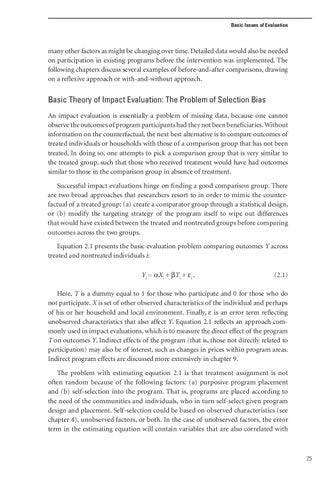Basic Issues of Evaluation
many other factors as might be changing over time. Detailed data would also be needed on participation in existing programs before the intervention was implemented. The following chapters discuss several examples of before-and-after comparisons, drawing on a reflexive approach or with-and-without approach.
Basic Theory of Impact Evaluation: The Problem of Selection Bias An impact evaluation is essentially a problem of missing data, because one cannot observe the outcomes of program participants had they not been beneficiaries. Without information on the counterfactual, the next best alternative is to compare outcomes of treated individuals or households with those of a comparison group that has not been treated. In doing so, one attempts to pick a comparison group that is very similar to the treated group, such that those who received treatment would have had outcomes similar to those in the comparison group in absence of treatment. Successful impact evaluations hinge on finding a good comparison group. There are two broad approaches that researchers resort to in order to mimic the counterfactual of a treated group: (a) create a comparator group through a statistical design, or (b) modify the targeting strategy of the program itself to wipe out differences that would have existed between the treated and nontreated groups before comparing outcomes across the two groups. Equation 2.1 presents the basic evaluation problem comparing outcomes Y across treated and nontreated individuals i: Yi = αXi + βTi + εi .
(2.1)
Here, T is a dummy equal to 1 for those who participate and 0 for those who do not participate. X is set of other observed characteristics of the individual and perhaps of his or her household and local environment. Finally, ε is an error term reflecting unobserved characteristics that also affect Y. Equation 2.1 reflects an approach commonly used in impact evaluations, which is to measure the direct effect of the program T on outcomes Y. Indirect effects of the program (that is, those not directly related to participation) may also be of interest, such as changes in prices within program areas. Indirect program effects are discussed more extensively in chapter 9. The problem with estimating equation 2.1 is that treatment assignment is not often random because of the following factors: (a) purposive program placement and (b) self-selection into the program. That is, programs are placed according to the need of the communities and individuals, who in turn self-select given program design and placement. Self-selection could be based on observed characteristics (see chapter 4), unobserved factors, or both. In the case of unobserved factors, the error term in the estimating equation will contain variables that are also correlated with
25
